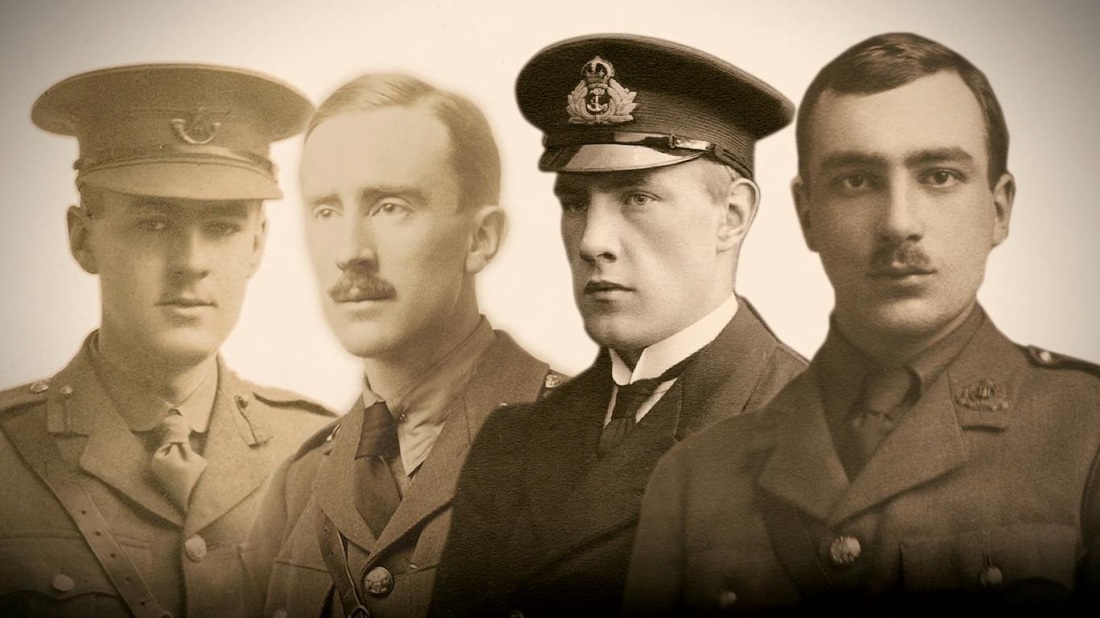Currently I am about to start episode 110 of the 'Exploring The Lord of the Rings' podcast, but one of the episodes I really wanted to talk about in the YouTube comments was episode 75: 'When Ringwraiths Attack'.
The first 2 slides set up the attack of the Ringwraiths and then the 3rd slide 'The Growing Shadows' ends with the following 2 sentences:
The next 4th slide 'The Assault Begins in Earnest' then starts with the sentence:

In literature women are categorised into three archetypes: Maiden, Mother, or Crone. I think Tolkien did the same for men, where the archetypes instead are: Hobbit, Warrior, and Wizard, and immortalised himself & his three friends into these following characters:
Geoffrey Smith and Robert Gilson did not make it in World War I, and it would have been therapeutic of Tolkien to express his PTSD into fictional writing. Have academics, who studied Tolkien in great deal, made similar connections? Or have I fallen into a conspiracy theorist rabbit hole and am I reading way to many things into those three quoted sentences? I am curious what you all think of this...
The first 2 slides set up the attack of the Ringwraiths and then the 3rd slide 'The Growing Shadows' ends with the following 2 sentences:
When I read: "a faint hiss" in this quote, my imagination goes immediately to a bullet flying through the air with in the background advancing enemy soldiers of a World War.Frodo thought that he heard a faint hiss as of venomous breath and felt a thin piercing chill. Then the shapes slowly advanced.
The next 4th slide 'The Assault Begins in Earnest' then starts with the sentence:
With my mind still in World War I, this reads to me as a death scene of 2 fellow soldiers. I have seen the movie 'Tolkien', so I know of the "big four" of the Tea Club, Barrovian Society, composed of Geoffrey Smith, JRR Tolkien, Christopher Wiseman, and Robert Gilson:Terror overcame Pippin and Merry, and they threw themselves flat on the ground.

In literature women are categorised into three archetypes: Maiden, Mother, or Crone. I think Tolkien did the same for men, where the archetypes instead are: Hobbit, Warrior, and Wizard, and immortalised himself & his three friends into these following characters:
Reality | ... | Hobbit | Warrior | Wizard |
|---|---|---|---|---|
Smith | ---> | Pippin | Legolas | Pallando |
Tolkien | ---> | Frodo | Aragorn | Gandalf |
Wiseman | ---> | Sam | Boromir | Radagast |
Gilson | ---> | Merry | Gimli | Alatar |
... | ... | ... | ... | ... |
Antagonist | ---> | Smeagol | Sauron | Saruman |
Geoffrey Smith and Robert Gilson did not make it in World War I, and it would have been therapeutic of Tolkien to express his PTSD into fictional writing. Have academics, who studied Tolkien in great deal, made similar connections? Or have I fallen into a conspiracy theorist rabbit hole and am I reading way to many things into those three quoted sentences? I am curious what you all think of this...
Last edited:
